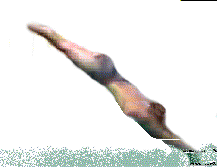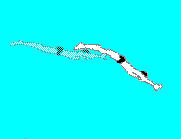

Torpedo Position
Beginning of water entry
The hands create a single hole for the rest of the body to follow through.


Reaching out in front with the arms instead of down also causes the back to arch.
The arched back is what we want when we enter the water to steer us up. The angle of entry is very steep from the height that we just obtained and we must be sure to straighten out so that we don't go deep! (Please see Safety Pages).
In a study of swimming racing-starts by Counsilman, Nomura, Endo and Counsilman (1988), 88 percent of the subjects went deeper than 0.9 meters and ten percent went deeper than 1.4 meters. To read some comments about how deep the entry angle should be click here. Reducing Drag During Glides.
As the height of the start-dive increases there are significant increases in the depth of the dive. In addition, pitch of the starting platform had a significant effect on the depth of the dives. The depth of the dives increased with an increase in angle of the starting platform. To see more about this subject of the underwater head depth and horizontal, vertical velocity and relationships from various heights of starting block platforms, see the CD-eBook.
WARNING
It's important to remember that the height of the dive increases the velocity and the depth of the dive. Velocity may be two-to-five times faster than what the swimmer is accustomed. It may be necessary that the swimmer practice from the side of the pool in deep water before proceeding with practice from a starting block if the swimmer has not learned steering skills. |
The most efficient depth for the maximum average velocity is at a depth less than 1 meter. The shallower the depth the faster the velocity. The optimum is between .4m and .9m. This is where it takes practice to hit the ultimate spot for each individual. (For information about the ultimate training system that automatically teaches this technique send an email to mailto:startmeister@hotmail.com).
The angle of entry will be deep as the body should enter through a single small hole in the water's surface and then quickly corrected. This direction change produces the Magic Surge (Stage 8). The reason for the quick correction is explained in more detail in the CD-eBook.